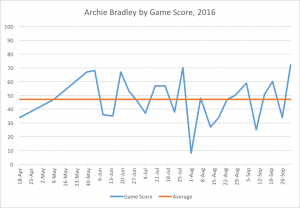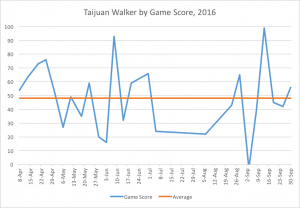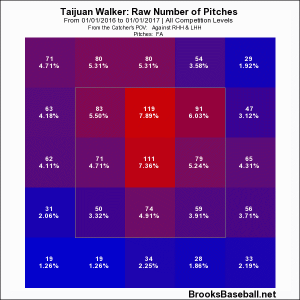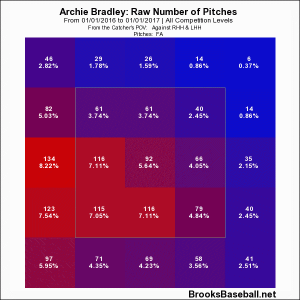Archie Bradley, Taijuan Walker, and Four-Seam Fastballs
It’s been fun profiling a couple of upcoming spring battles lately. There’s going to be some kind of rotation battle between some young, talented starters, and it’ll be intriguing to see how all of the infield pieces fit together. Avoiding the bullpen has been purposeful to date given the team might not be done adding there (more acquisitions today!), but the outfield and catching positions are probably what they’re going to be. And for all the questions about Yasmany Tomas, who’ll catch the most, and Jake Lamb versus lefties (again), the biggest issue facing this team is very familiar: starting pitching. And, we can zero in even further as it pertains to the future of the Diamondbacks: can Taijuan Walker and Archie Bradley become highly productive young pitchers?
I really don’t want to belabor this point any further — someone’s going to the bullpen (or the minors) this season from the group of Bradley, Patrick Corbin and Shelby Miller. I’ve written about it twice already, so let’s consider this “established” for today, even if you’re inclined to disagree. For a bunch of reasons, I think that’ll end up being Bradley to the bullpen — whatever, that’s not really here nor there for today. But you’ll notice that I didn’t include Walker in the group that’s on the bubble. Perhaps that’s a little curious in its own right, but for me, he’s going to stay in the majors and in the rotation as the D-backs gave up plenty to get him. They’ve invested, they want to reap the rewards of that investment, and the best way to do so is to make Walker a more consistently good starting pitcher.
If we’re talking about demoting Bradley, should we be considering demoting Walker? Let’s take a look at their 2016 seasons by game score, a year in which Bradley made 26 starts (5.02 ERA, 5.13 DRA) in his age-23 season while Walker made 25 starts (4.22 ERA, 4.27 DRA) in his age-23 season.
While Walker’s ERA and DRA were clearly better than Bradley’s, his average game score (48.2) was only one point better (Archie averaged 47.2). Neither mark is especially good, but for all of those great starts for Walker, he had some that were absolutely horrific. Bradley didn’t have the high-highs, but avoided some of the low-lows. Both clearly have some growing to do, and consistency is a big piece of the puzzle.
I should apologize for burying the lede, but here it is: both have had trouble with their fastball. If you’ve watched any of Archie Bradley’s work over the last two years, you’ve taken notice. Walker’s issues aren’t perhaps as bad, but he’s had a hell of a time keeping the ball in the park as he given up 52 home runs in 54 starts over the past two seasons. By my count, 28 of those home runs have come on four-seam fastballs. Meanwhile, Bradley can’t throw his where he wants to either, and both have had significant issues with the heat from time to time. We’ve seen starts where Bradley is racking up low strikes and Walker is blowing hitters away with them up in the zone. But we’ve also seen plenty where the fastball isn’t sharp, it’s not thrown for strikes to get ahead, and it catches a little too much plate. Sure, this happens to every pitcher from time to time, but it’s happened more than enough to these two in their young careers.
Both Bradley and Walker have the ability to run their fastballs up to the plate in a hurry — Bradley reached 96.9mph last season while Walker touched 98.4mph — but there’s clearly more to a fastball than velocity. I decided to take a look at all qualified starters that threw a four-seamer in 2016 to get an idea of how the young D-backs’ fastballs measure up to larger sample. With 70 pitchers under review, here’s how Bradley and Walker’s four-seamers stack up:
Both Bradley and Walker have fastballs that would be described as “jumping fastballs” based on the work of Max Marchi, who now works in the Cleveland Indians’ analytics department after doing great research for Baseball Prospectus. Both have above average velocity and both have above average vertical movement (or “rise”). Walker has a touch more horizontal movement on his four-seamer than average while Bradley is about 3/4″ below average. Take a look at both fastballs in action below.
Bradley’s strikeout of Chris Heisey comes on a 94.1mph fastball at the knees on the inside corner as it just nips the edge of the strike zone. Walker strikes out Jorge Polanco with a 94.2mph four-seamer that’s up and out of the zone. Heisey takes and Polanco whiffs, but both pitches show arm-side run with good velo. Bradley’s fastball has enough “rise” to catch the bottom of the zone while Walker’s has enough “rise” to stay out of the zone.
In fact, how they use their four-seamers points to a great divergence. Walker’s disposal of Polanco above isn’t a misrepresentation of how he likes to use the heat. Here’s his four-seam heat map from 2016:
And here’s the same heat map for Bradley who seems to consistently use his four-seamer in a particular way:
Walker clearly doesn’t mind using his fastball up as he challenges hitters regularly. Meanwhile, Bradley has a clear plan of attack, trying to keep the fastball down and to his arm side. Though they have similar fastballs in terms of movement and velocity, they certain go about using them differently. One can see where Walker can get into trouble with the long ball if/when those fastballs up in the zone get hit hard — they’re in a prime location to travel a long way. For Bradley, he misses the zone with the heat regularly, as he’s consistently trying to nip a small part of the strike zone, usually missing off the plate. Both flirt with disaster, just in different ways. Walker has been prone to the homer, Bradley the walk.
This wouldn’t be such a huge problem were it not for the fact that both young righties rely on their four-seamers so often. Here are the top five qualified starters for four-seam fastball usage, with Bradley and Walker thrown in at the bottom:
Bradley leans on his four-seam fastball a ton while even Walker would rank in the top five among all qualified starters if he had, well, qualified for the pitching title. Both throw their four-seamers a lot, placing extra pressure on the pitch. For Bradley, he doesn’t have a useful third pitch, forcing him to throw his four-seamer a bunch, then mix in the occasional curveball. Meanwhile, Walker relies on the fastball to do most his work, mixing in splitters and curves. Though Walker does mix things up more than Bradley, both pitchers can be prone to hitters hunting fastballs because they know they’re going to get them.
With the Diamondbacks staking so much hope on this pair of right-handed youngsters, and those youngsters’ reliance on the four-seam fastball, it’s critical that both pitchers take a step forward with their primary heaters. Best of all, the two can learn something from one another. Bradley might be well-served to challenge hitters more frequently with his fastball, using it up in the zone more and trying to get it in on the hands of right-handed hitters or up and out of the zone to lefties. Meanwhile, Walker may benefit from trying to locate a few more four-seamers down in the zone and on the corners. That’s not an easy task for either pitcher, but both need to make improvements with the four-seam fastball, especially if they’re going to keep relying on the pitch to the lion’s share of their work. As we watch both pitchers get to work in the Cactus League, we should keep a close on eye on the location of their four-seamers to see if adjustments are forthcoming or if they’ll stick to the script.
2 Responses to Archie Bradley, Taijuan Walker, and Four-Seam Fastballs
Leave a Reply Cancel reply
Recent Posts
@ryanpmorrison
 Best part of Peralta’s 108 mph fliner over the fence, IMHO: that he got that much leverage despite scooping it out… https://t.co/ivBrl76adF, Apr 08
Best part of Peralta’s 108 mph fliner over the fence, IMHO: that he got that much leverage despite scooping it out… https://t.co/ivBrl76adF, Apr 08 RT @OutfieldGrass24: If you're bored of watching Patrick Corbin get dudes out, you can check out my latest for @TheAthleticAZ. https://t.co/k1DymgY7zO, Apr 04
RT @OutfieldGrass24: If you're bored of watching Patrick Corbin get dudes out, you can check out my latest for @TheAthleticAZ. https://t.co/k1DymgY7zO, Apr 04 Of course, they may have overtaken the league lead for outs on the bases just now, also...
But in 2017, Arizona ha… https://t.co/38MBrr2D4b, Apr 04
Of course, they may have overtaken the league lead for outs on the bases just now, also...
But in 2017, Arizona ha… https://t.co/38MBrr2D4b, Apr 04 Prior to the games today, there had only been 5 steals of 3rd this season (and no CS) in the National League. The… https://t.co/gVVL84vPQ5, Apr 04
Prior to the games today, there had only been 5 steals of 3rd this season (and no CS) in the National League. The… https://t.co/gVVL84vPQ5, Apr 04 RT @OutfieldGrass24: Patrick Corbin has a WPA of .318 and it's only the fifth inning., Apr 04
RT @OutfieldGrass24: Patrick Corbin has a WPA of .318 and it's only the fifth inning., Apr 04
Powered by: Web Designers@outfieldgrass24
 Old friend alert https://t.co/xwSHU0F8Hn, 1 hour ago
Old friend alert https://t.co/xwSHU0F8Hn, 1 hour ago Every once in a while you get a beer that's just a little off... Usually happens to me at airports., 7 hours ago
Every once in a while you get a beer that's just a little off... Usually happens to me at airports., 7 hours ago If Pollock doesn’t sign with a team that wears red uniforms I’m going to be really disappointed. Working theory: Se… https://t.co/zHn9DqzEiD, 9 hours ago
If Pollock doesn’t sign with a team that wears red uniforms I’m going to be really disappointed. Working theory: Se… https://t.co/zHn9DqzEiD, 9 hours ago The work here by @Britt_Ghiroli is splendid https://t.co/c8tSq0vw3T, 9 hours ago
The work here by @Britt_Ghiroli is splendid https://t.co/c8tSq0vw3T, 9 hours ago RT @TheAthleticAZ: Plenty of #Dbacks fans gave it some time - and they still don't like the idea. The "why" from @ZHBuchanan
https://t.co/9oDlvue3fV, 18 hours ago
RT @TheAthleticAZ: Plenty of #Dbacks fans gave it some time - and they still don't like the idea. The "why" from @ZHBuchanan
https://t.co/9oDlvue3fV, 18 hours ago
Powered by: Web Designers











Two “interpretations” drawn from Bradley’s heat map? 1. Bradley went extreme up and in only 6 times to RH hitters, and only close both up and in 14 times each. My interpretation? Because Bradley got hit in the face by a line drive, he fears one of his pitches might do the same to a hitter. So he’s afraid to pitch inside. 2. Bradley has better control than Walker does. He has higher concentrations of numbers outside and low than Walker has anywhere on the heat map. Interpretation? Bradley has higher potential to harness his fastball effectively that Walker does, which would make Bradley a better late inning reliever. I expect huge disagreements to these “interpretations”!
I’ve been re-watching starts from both of these pitchers in the last couple of weeks and I’m not sure I’d say Bradley has better control, necessarily. I think it’s mostly that they have very different ways of using the four-seamer. Walker likes to elevate the pitch and he does so purposely.
My big thing here is that they’re both predictable with their fastballs. With Walker, you know where he’s throwing it. Same for Bradley. Bradley doesn’t throw the pitch to his glove side much and I believe that’s hurting him. I understand that he doesn’t want to throw it out there and have it leak back over the plate, but he’s pitching to the same spot no matter who’s at the plate. With Walker moving to Chase Field, those fastballs up could be especially problematic if he doesn’t mix a few of them down. Luckily it’s a very good fastball and it’s tough to hit well, but he needs to avoid the heart of the plate.
There are developmental steps left for both and fastball command are the most pressing, for me. Especially in Bradley’s case, being a one-trick pony isn’t ideal. Walker’s breaking ball could stand to improve, hopefully taking some of the pressure off his heater.